FME Transformers: 2025.2
Sorts the points within a point cloud by one or more component values.
Typical Uses
- Sorting point cloud points in preparation for further manipulation or analysis
How does it work?
The PointCloudSorter receives point cloud features, and re-orders the points within them according to selected component values. The sort order may be either ascending or descending.
Sorting may be done on more than one component, in which case the points are sorted primarily by the first selected component and order, secondarily by the second, and so on.
Multiple point clouds may be sorted, and each one will be sorted individually (not merged).
Examples
In this example, we will use point cloud sorting to identify the lowest points in a point cloud, removing vegetation to produce a bare earth representation of the area.
Note that the source point cloud is a heavily forested area, shown here from an oblique angle in the FME Data Inspector, and the highest point is 145.92 meters.
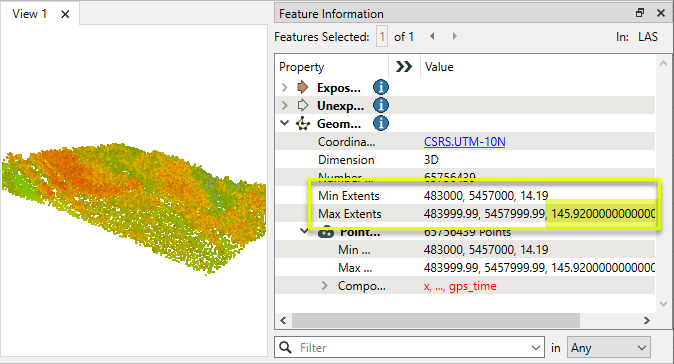
We will use three steps to find the lowest points:
- Round the x and y coordinates to a chosen grid size with a PointCloudExpressionEvaluator,
- Sort the points by elevation with a PointCloudSorter, in ascending order, so the lowest points occur first, and
- Merge the point cloud with itself to isolate the lowest point at each location, using a PointCloudMerger.

Step 1 - Round the coordinates
The point cloud is first routed into a PointCloudExpressionEvaluator. In the parameters dialog, the x and y components are recalculated, using an expression that rounds them to a specific interval - in this case, 10 meters.
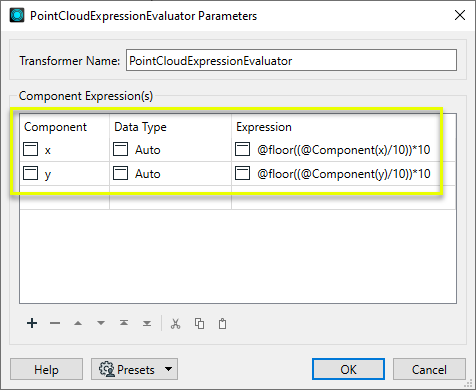
Step 2 - Sort the points by elevation
Next, the point cloud is sent to a PointCloudSorter. In the parameters dialog, we sort based on the z component, in Ascending order.
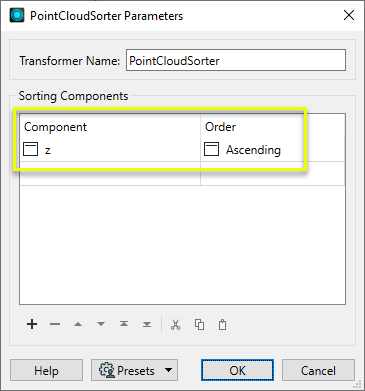
The result of these first two transformers is a point cloud that still contains all original points, but they have been shifted onto a regular xy grid with 10 meter spacing, and internally, the points occur in ascending order of elevation and so will subsequently be processed in that order.
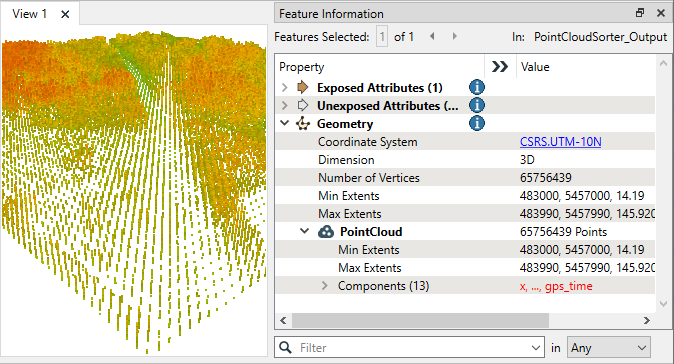
Step 3 - Isolate the lowest points
Next, the sorted point cloud is merged onto itself in a PointCloudMerger, routing a copy into both the Requestor and Supplier input ports.
The Referenced output port produces a point cloud containing the first occurrence of any given x,y pair. Since the lowest ones will be processed first due to the sorting, those are the points that will be kept.
(See the PointCloudMerger for a complete example of removing duplicates in a point cloud.)
In the parameters dialog, we join on the x and y components only - not z.
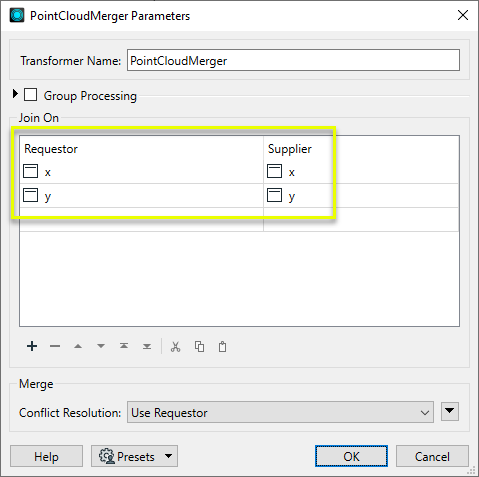
After sending the Referenced point cloud through a PointCloudPropertyExtractor (not shown in the workspace above) to calculate its new x, y, and z extents, we can see the bare earth representation as points spaced 10 meters apart, and with a new maximum elevation of 98.28 meters.
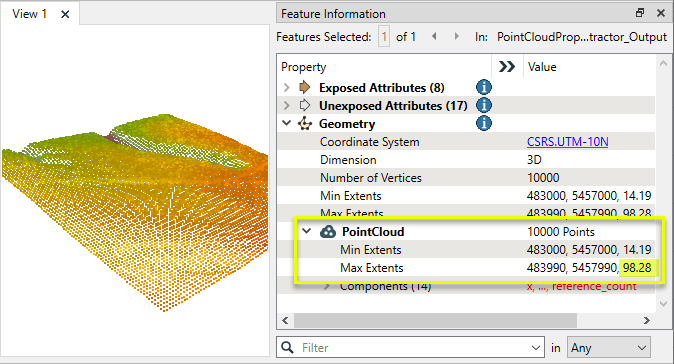
Usage Notes
Choosing a Point Cloud Transformer
FME has a selection of transformers for working specifically with point cloud data.
For information on point cloud geometry and properties, see Point Clouds (IFMEPointCloud).
|
Combines features into a single point cloud. Point cloud and non-point cloud geometries are supported. |
|
|
Adds new components with constant values to a point cloud. |
|
|
Copies selected component values onto either a new or existing component |
|
|
Keeps only specified point cloud components, discarding all others. |
|
|
Removes specified components from a point cloud. |
|
|
Renames an existing component. |
|
|
Alters the data type of point cloud components, and converts component values if required. |
|
|
Reads point cloud features for testing purposes, including any accumulated point cloud operations. No additional operations are performed, and nothing is done with the features. |
|
|
Creates a point cloud of specified size and density, with default component values. |
|
|
Evaluates expressions on each point in a point cloud feature, including algebraic operations and conditional statements, and sets individual point cloud component values. |
|
|
Serializes the geometry of a point cloud feature into a Blob attribute, encoding the contents according to a choice of common binary point cloud formats. |
|
|
Separates point clouds into multiple features, based on evaluating expressions including component values, and creates a separate output port for each expression defined. |
|
|
Merges point clouds by joining points where selected component values match (join key), including x, y, z, and other components. Component values are transferred between point clouds and output is filtered based on matching success and duplication. |
|
|
Sets point cloud component values by overlaying a point cloud on a raster. The component values for each point are interpolated from band values at the point location. |
|
|
Extracts the geometry properties of a point cloud feature and exposes them as attributes, optionally checking for their existence, retrieving component properties, and finding minimum and maximum values. Extents may also be recalculated and updated. |
|
|
Decodes a binary attribute containing encoded point clouds stored as Blobs, replacing the feature’s geometry with the decoded point cloud. |
|
|
Reduces the number of points in a point cloud by selectively keeping points based on the shape of the point cloud. The simplified and removed points are output as two discrete point clouds. |
|
|
Sorts the points within a point cloud by one or more component values. |
|
|
Separates point clouds into multiple features based on component values, color, or first/last return. |
|
|
Calculates statistics on point cloud components and adds the results as attributes. |
|
|
Takes an input point cloud and reconstructs it into an output mesh. |
|
|
Reduces the number of points in (thins) a point cloud by keeping points at a fixed interval, a maximum number of points, or a set quantity of first or last points. Remaining points are discarded. |
|
|
Converts point clouds to point or multipoint geometries, optionally retaining attribute and component values. |
|
|
Applies a point cloud’s scale, offset, or transformation matrix to it, recalculating component values and removing the transformation values. |
Configuration
Input Ports
This transformer accepts only point cloud features.
Output Ports
Point cloud features with points sorted according to parameter selections.
Non-point cloud features will be routed to the <Rejected> port, as well as invalid point clouds.
Rejected features will have an fme_rejection_code attribute with one of the following values:
INVALID_GEOMETRY_TYPE
Rejected Feature Handling: can be set to either terminate the translation or continue running when it encounters a rejected feature. This setting is available both as a default FME option and as a workspace parameter.
Parameters
This table specifies the components by which the point cloud will be sorted.
Sorting is done in the order specified. That is, all points will be sorted by the values of the first component in the list. If there are any ties, they will be broken by the values of the second component, then the third component, and so on.
|
Component |
Specify a component for sorting. The drop-down menu provides a list of standard component names. User-specified component names may be entered directly. |
|
Order |
Select the sort order:
|
Editing Transformer Parameters
Transformer parameters can be set by directly entering values, using expressions, or referencing other elements in the workspace such as attribute values or user parameters. Various editors and context menus are available to assist. To see what is available, click  beside the applicable parameter.
beside the applicable parameter.
Defining Values
There are several ways to define a value for use in a Transformer. The simplest is to simply type in a value or string, which can include functions of various types such as attribute references, math and string functions, and workspace parameters.
Using the Text Editor
The Text Editor provides a convenient way to construct text strings (including regular expressions) from various data sources, such as attributes, parameters, and constants, where the result is used directly inside a parameter.
Using the Arithmetic Editor
The Arithmetic Editor provides a convenient way to construct math expressions from various data sources, such as attributes, parameters, and feature functions, where the result is used directly inside a parameter.
Conditional Values
Set values depending on one or more test conditions that either pass or fail.
Parameter Condition Definition Dialog
Content
Expressions and strings can include a number of functions, characters, parameters, and more.
When setting values - whether entered directly in a parameter or constructed using one of the editors - strings and expressions containing String, Math, Date/Time or FME Feature Functions will have those functions evaluated. Therefore, the names of these functions (in the form @<function_name>) should not be used as literal string values.
| These functions manipulate and format strings. | |
|
Special Characters |
A set of control characters is available in the Text Editor. |
| Math functions are available in both editors. | |
| Date/Time Functions | Date and time functions are available in the Text Editor. |
| These operators are available in the Arithmetic Editor. | |
| These return primarily feature-specific values. | |
| FME and workspace-specific parameters may be used. | |
| Creating and Modifying User Parameters | Create your own editable parameters. |
Table Tools
Transformers with table-style parameters have additional tools for populating and manipulating values.
|
Row Reordering
|
Enabled once you have clicked on a row item. Choices include:
|
|
Cut, Copy, and Paste
|
Enabled once you have clicked on a row item. Choices include:
Cut, copy, and paste may be used within a transformer, or between transformers. |
|
Filter
|
Start typing a string, and the matrix will only display rows matching those characters. Searches all columns. This only affects the display of attributes within the transformer - it does not alter which attributes are output. |
|
Import
|
Import populates the table with a set of new attributes read from a dataset. Specific application varies between transformers. |
|
Reset/Refresh
|
Generally resets the table to its initial state, and may provide additional options to remove invalid entries. Behavior varies between transformers. |
Note: Not all tools are available in all transformers.
For more information, see Transformer Parameter Menu Options.
Reference
|
Processing Behavior |
|
|
Feature Holding |
No |
| Dependencies | None |
| Aliases | |
| History |
FME Online Resources
The FME Community and Support Center Knowledge Base have a wealth of information, including active forums with 35,000+ members and thousands of articles.
Search for all results about the PointCloudSorter on the FME Community.
Examples may contain information licensed under the Open Government Licence – Vancouver, Open Government Licence - British Columbia, and/or Open Government Licence – Canada.




